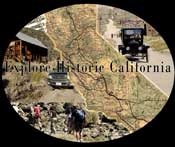|
For
nearly thirty years I have known of the historic Rowley House in my
neighborhood of Sunland/Tujunga. In the past ten years it finally
dawned on me that the magnificent rock house I regularly passed on
the backroads to the Sunland post office was the same one pictured
in my local history books. Somehow I missed the year it was offered
on our historic house tour. In the last year, I have been given a
personal glimpse into the past and present of this wonderful home,
thanks to newfound friendships. This is the second in a series about
the house and the hardy and often boisterous pioneers who called it
theirs in the early days of what was then known as Monte Vista
Valley.
Life in Monte
Vista Valley was crude at best. The few families that lived there
traveled back and forth on wagon wheel rutted dirt roads that were
famous for flooding when the rains came. Food would have been grown,
raised, or hunted, or bartered with occasional trips several miles
away to the big city for supplies. Mail was brought in by Loron T.
Rowley, who would travel to Roscoe Station where steam trains
delivered it.
 |
|
Panoramic view of the Vale of Monte Vista looking east,
1912.
(Photo
courtesy CSUN/ San Fernando Valley History Digital
Library) |
By 1885, Loron
put his entrepreneurial skills together and contracted with land
promoters to build a two story general store and mail distribution
outlet. The goods he provided and the mail he brought in primarily
took care of the needs of the developers and their construction
workers. Loron would take his wagon down to Los Angeles, buy the
necessities to outfit his store, spend the night in the city, and
then come back the next day.
Monte Vista
pioneers took advantage of the school at the west end of the little
Valley. The children often walked many miles to get there, in all
manner of weather, through prickly shrub, kicking up dust or
tramping through mud and floodwaters according to the season. The
boys sometimes carried guns, making sport of shooting jackrabbits
along the way. The gun also came in handy to kill the rattlesnakes
they encountered in warm weather.
The school
boys could be rough and full of antics. The school master, probably
not much older than they were, made switches out of willow to
discipline them. He kept these switches on his desk in front of the
classroom to serve as warning. One of the boys surprised him by
pulling out a knife and another pulled his gun, and mocked the
teacher by placing their weapons on their own desks. That afternoon,
as the teacher was on his way home from school, the sound of gun
shots were heard; Bullets whistled by his ears. Although it was
later claimed it was all in good clean fun, the schoolmaster
couldn’t take the pressure, and quit. The one room schoolhouse was
closed.
Loron Rowley
was a prominent citizen of Monte Vista, always looking out for the
needs of his rural community. When he realized that the school
needed a new teacher, he sent word to his brother Quinton, a doctor
in Downey. Quinton found twenty-one year old Virginia Florence
Newcomb, a graduate of the Normal School in Los Angeles. As the
daughter of a Civil War sergeant and the only girl in a family of
all boys, Virginia had no fear, and presided over the one room
school providing a well disciplined educational atmosphere that was
much needed.
During the two
years that Virginia taught, Loron, ten years older than she, courted
her. By 1893 they were married and living on his homesteaded ranch
further up the hills. The Monte Vista Valley had grown by this time,
with large acreage ranches full of orchards, vineyards, and olive
groves. Loron financed his growing family running the first valley
freight line, and operating the store. Virginia tended to the home
gardens, and household chores, and took care of their son Eustace.
The land boom
died down and the old Monte Vista Hotel fell into the hands of
Loron’s brother Quintin. The little family moved into the hotel to
keep an eye on it for him, and while living there two more children
came along. Eustace had a brother at last in 1898, and their first
sister, Dorothy, was born in 1902. The hotel was a fun place for the
children, particularly the more adventurous Robert, who enjoyed
climbing on the balconies, chasing bats out of the belfry and racing
his bike around the huge wraparound porch. The roof of the hotel
looked interesting as a slide, but nearly proved fatal to the young
boy. In his memoirs later, Robert would write, “I grew up learning
to determine what I wanted to do. I had chores, of course, but other
than that I was turned loose, and nobody told me what I shouldn’t
do. If it was there to do, you went ahead and did it. I could tackle
anything.”
The Rowley
family moved back to the ranch a year after Dorothy was born.
Eustice and Robert walked the two miles to school, entertaining
themselves along the way shooting jack rabbits with the family’s 12
gauge Winchester pump gun for target practice, like the rowdy boys
that their mother had tamed in that early schoolhouse. The gun
policy and discipline had changed at the school, so the boys would
hide the gun before entering it to avoid having to relinquish it to
the teacher. This teacher kept a stern hand on his students and was
known to crack their fingers if they misbehaved. The students still
enjoyed their pranks, however. During a field trip to a pasture to
collect mistletoe, when the teacher got caught in the bog, the kids
ignored his cries for a long while before actually coming to his
rescue.
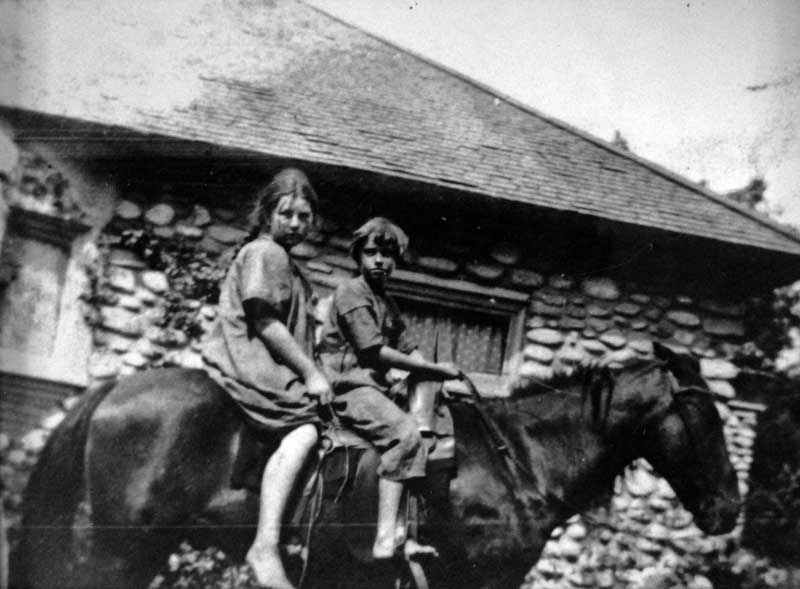 |
|
Undated
photo of Rowley girls on horseback with Rowley house in
background.
(Photo
courtesy Rowley House Collection) |
Families could
not survive easily without guns and hunting in the early days of
Monte Vista Valley. Jackrabbits and quail were common family
dinners. The bigger game, such as deer, was cause for celebration,
with the entire town joining in on preparation and eating. When a
young Robert Rowley insisted on hunting with his uncles, Virginia
placed a shotgun in his hands herself. Once he could fire the gun
without being knocked over, he was allowed to join the hunting
parties. At the age of thirteen, the first deer he shot weighed in
five pounds more than he was, and the men probably laughed at his
attempts to lift it onto his shoulders and bring it back himself.
Robert and Eustace were both quick to jump out of bed and grab their
guns in the middle of the night when a coyote threatened Viriginia’s
chicken coop. Non-hunting trips into the Big Tujunga wash for
hiking, horseback riding, or swimming, guns were packed even by the
women, in case they ran across a deadly rattlesnake.
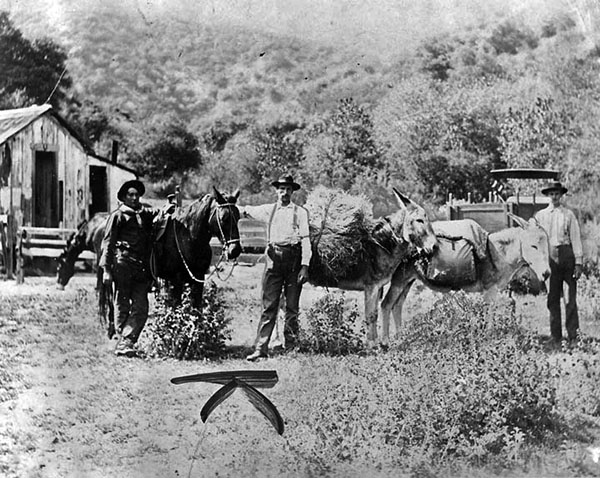 |
|
A farm
at the corner of Haines Canyon and Tujunga Canyon
Boulevard, 1910. Men in suspenders and hats, some with
holster and gun, stand beside a saddled horse and
donkeys loaded with bags and hay.
(Photo
courtesy Los Angeles Public Library Collection) |
Hunting helped
to feed the Rowley family in other ways. Loron and young Robert
provided guide service into the mountains for the city hunters that
came by way of rail into Roscoe Station. After settling the men into
a hotel in the little town, they would guide them the 8 miles up the
big Tujunga Canyon, leave them there, then come back later and bring
them back to the railroad station. On one particular day, Robert was
asked to hitch up the two seated surrey with a one horse rig and
bring the hunters back himself. The river was high, and the road was
washed out in thirteen or fourteen places, making travel difficult.
In the rush to meet the noon train, a bolt fell out of the front
axle of the wagon. Robert was pulled over the front running board
and dumped face first into the sand as the horse and shaft loosened.
The men reconnected the bolt and shaft, but the rough road jiggled
everything loose once again. A bruised Robert happily relinquished
his driving job to one of the hunters. The older driver, confident
in his driving skills, went along fine, until he whipped the horse
and hit a bump and turned the wagon over also. Robert, more familiar
with the area, took over the reins one again.
The roads up
the local canyons flooded often, and Robert, at the age of ten or
eleven made it his job to rescue those that got stuck or trapped.
Carriage or wagons were often impractical, so Robert would saddle up
his horse, leading one or two others into the mountains. Handling
three horses tied together in three different positions in stream
crossings was difficult at best. His horse, in the middle of the
river, stumbled through the crossings. Robert was fearful the two
tethered horses would pull back and pull him under. He finally
learned that a longer rope would move him across safely with his
mount, before the other horses hit the water. “Whether they wanted
to or not, I’d pull them through.” Robert would later recall.
 |
|
Birdseye
view of Tujunga, 1920. Several wide, dirt roads from a
grid on the floor of a valley at center. Most of the
land between the streets is covered with dense bushes.
The San Gabriel Mountains and Big Tujunga Canyon stretch
across the image from left to right.
(Photo
courtesy University of Southern California Libraries) |
In 1909, Loron
traded some of his land for a Cadillac to run the mail and the stage
from Sunland to Roscoe. Breakdowns were often, and Loron himself
wasn’t knowledgeable in repair. Robert brought his horse to be
hitched in front and would pull the car while Loron steered behind
the wheel. It was a ten mile pull to the garage in Burbank. On the
way home, the horse was tied to the back of the Cadillac and trotted
home. Eventually, Robert learned to repair the car himself, saving
the family a great deal of money. Robert and his friends also used
their knowledge to help others in similar plights. Dr. Speight's
vehicle often refused to start after church, and he would give the
boys 50 cents to start it for him. The boys learned to disconnect a
part while the doctor was in church, just so they could earn their
50 cents.
|
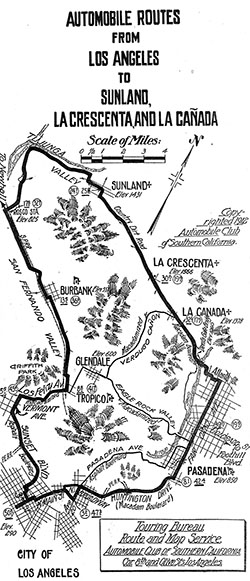 |
|
1912
Auto Club strip map of Los Angeles up to Sunland via La
Crescenta and La Cañada.
(Map
courtesy
University of Southern California Libraries) |
As Monte Vista
Valley began to grow, and the communities of Sunland Tujunga slowly
built up in and around it, two old mules would be used to pull
lumber from loaded wagons all the way from Glendale for the first
subdivision homes. The Rowley family hauled out the cut wood to the
city on sleds from the hills, and transferred the wood to a wagon.
The customers brought in by train by hungry real estate people were
entertained with big barbeques and beer busts, and the hunting trips
into the mountains. The early pioneer families such as the Rowley’s
paved the way as they enjoyed their own rural way of life and
provided much needed services for each other, and those that would
follow them.
 |
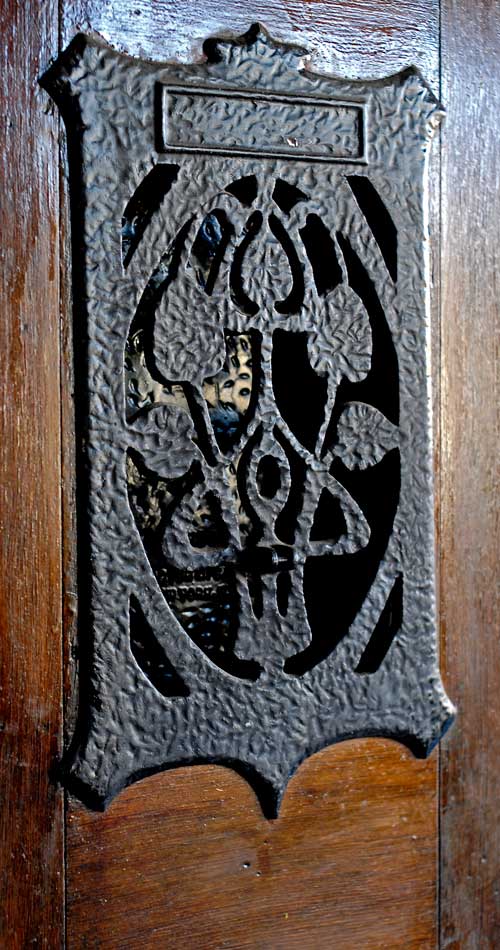 |
The
Rowley house today. |
Bibliography
From Crackers to Coal Oil
by Mary Lee Tiernan
The Early History of
Sunland, California, Voume IV
Snoops Desktop Publishing
Sunland, California 91040
Founding sisters - Life Stories of Tujunga’s Early Women Pioneers
1886-1926
by Mary Lou Pozzo
Zinnia Press
Tujunga, California 2005
Rancho Tujunga
A History of Sunland/Tujunga, California
Compiled by Sarah R.
Lombard
Published by Sunland
Woman’s Club
Produced by Bridge
Publishing
Burbank, California
Sunland and Tujunga From Village To City
by Marlene A. Hitt
Little Landers Historical
Society
Arcadia Press, 2002
Panoramic view of Monte Vista Valley photo courtesy San
Fernando Valley History Digital Library Collection
http://digital-library.csun.edu/SFV/
Tujunga farm photo photo courtesy Los
Angeles Public Library (Herald Examiner Collection)
http://photos.lapl.org/carlweb/jsp/photosearch_pageADV.jsp
Birdseye view of Tujunga, 1920 photo
and 1912 Auto Club map courtesy University of Southern California
Libraries
http://digitallibrary.usc.edu/search/controller/index.htm
Special thanks to the
current residents of the Rowley House for graciously sharing their
personal archives with us.
NOTE: According
to Sarah Lombard various old maps show “Tuhunga” on the Southern
Pacific Railroad, near Little Tujunga Canyon. An early post office
was located between the town of San Fernando and the confluence of
Big and Little Tujunga Rivers. There was a post office established
in “Tuhunga” on January 5, 1885 through March 3, 1894.
The first post master was
J. S. Florey. Mail was received from San Fernando by Rural Free
Delivery after 1894. The actual town of Monte Vista (now Sunland)
was platted in March 1885. Sherman Page and F. C. Howes were
responsible for sales of lots and acreages for farms
|
